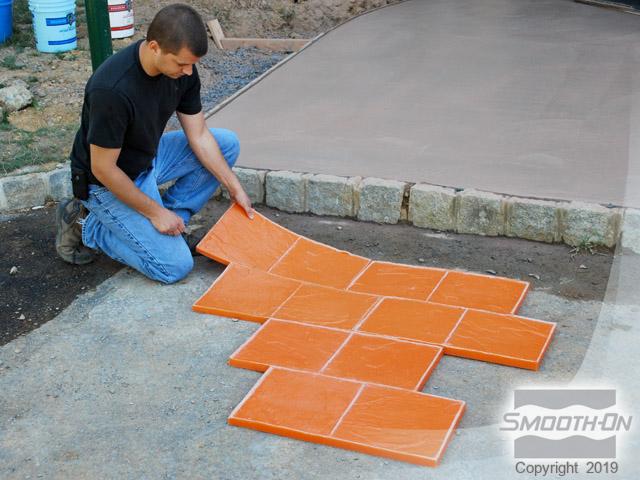Are you tired of the outdated tile on your concrete floor and looking to give it a fresh look? Removing tile from a concrete floor may seem daunting, but with the right tools and techniques, it can be a manageable DIY project. In this article, we will guide you through removing tile from a concrete floor, from gathering the necessary tools to cleaning and finishing the concrete surface.
Firstly, you’ll need to gather the necessary tools for this project. These include a hammer, chisel, pry bar, safety goggles, and gloves. Once you have all the tools ready, it’s time to prepare the area for tile removal. This involves clearing the space of any furniture or objects and protecting the surrounding areas with drop cloths or plastic sheets to prevent any damage.
Next, it’s time to get down to the nitty-gritty of removing the tile. Start by removing the grout between the tiles using a grout saw or a rotary tool with a grout removal attachment. This step is important as it allows for easier tile removal. Once the grout is removed, use a hammer and chisel to break and remove the tiles. Work carefully, starting from the edges and slowly moving towards the center of each tile. Finally, clean the concrete surface thoroughly, removing any adhesive residue or debris. Finish off by applying a concrete sealer to protect the surface and give it a polished appearance. With these simple steps, you’ll be able to easily remove tile from your concrete floor and transform your space.
Gathering the Necessary Tools
To remove tile from a concrete floor, gather the following tools: a floor scraper, hammer or chisel, rubber mallet (optional), pry bar, utility knife with replacement blades, safety goggles, and gloves. Choose sturdy and sharp tools, prioritize safety, and use the pry bar and utility knife to remove stubborn tiles and adhesive.
Preparing the Area for Tile Removal
To remove tiles from a concrete surface, follow these steps:
- Clear the area and remove furniture or obstacles.
- Cover nearby surfaces and furniture to protect them.
- Wear protective gear such as gloves, safety glasses, and a dust mask.
- Inspect and remove any loose or damaged tiles first.
- Use a putty knife or chisel to gently pry up the loose tiles.
- Break the remaining tiles into smaller pieces using a hammer and chisel.
- Start at the edges and work towards the center.
- Remove the broken tiles from the concrete floor.
By following these steps, you can effectively remove tiles from a concrete surface. However, you could always ask for help from a reputable concrete contractor near you. They will provide you with the best results.
Removing the Grout
To remove grout from your tiles, there are a few methods you can use. One option is to use a grout saw, a hand tool with a serrated blade that allows you to scrape away the grout. Another option is to use a rotary tool with a grout removal attachment, which vibrates the grout for easier removal. Whichever method you choose, be sure to wear protective goggles and gloves. Removing the grout is an important step in preparing the area for tile removal without damaging the tiles.
Breaking and Removing the Tiles
To remove stubborn tiles, follow these steps:
- Wear safety goggles and gloves.
- Tap a chisel and hammer on the corner of a tile to loosen it.
- Pry the tile up with the chisel, being careful not to damage the concrete.
- Repeat for each tile until they are all removed.
- Use power tools like an angle grinder or rotary hammer drill for difficult tiles, following safety instructions.
- Clean up loose debris with a broom and dustpan.
- Use a scraper or putty knife to remove any remaining adhesive or mortar.
- Once the floor is clean, proceed to the next step.
Cleaning and Finishing the Concrete Surface
Now that you have successfully cleared away the tiles, it’s time to thoroughly clean and finish the concrete surface to reveal its true potential. The first step in this process is to remove any remaining adhesive or mortar that may be stuck to the floor. You can use a scraper or a chisel to carefully scrape off the adhesive, being careful not to damage the concrete surface. If the adhesive is particularly stubborn, you can use a solvent or adhesive remover to soften it before scraping it off.
Once the adhesive is removed, it’s important to thoroughly clean the concrete surface to remove any dust, dirt, or debris. Start by sweeping the floor to remove loose dirt and debris, and then use a wet mop or a pressure washer to clean the entire surface. If there are any stubborn stains or marks on the floor, you can use a mild detergent or a concrete cleaner to spot-clean those areas. After cleaning, allow the floor to dry completely before moving on to the next step.
After the concrete surface is clean and dry, it’s time to finish and protect it. Several options for finishing a concrete floor include applying a sealer, a stain, or a paint. A sealer can help protect the concrete from stains and make it easier to clean, while a stain or paint can add color and enhance the floor’s appearance. Before applying any finish, read and follow the manufacturer’s instructions, and test the finish in a small, inconspicuous area to ensure that you are happy with the results. Once the finish is applied, allow it to dry completely before using the floor.
You can always count on our concrete company to answer your questions and give you a free estimate for all your cement and concrete projects. We provide a wide range of concrete services in Michigan, and we’re always happy to help you with cement and concrete work.
Have Questions? Contact Us Now!
Frequently Asked Questions
How do I prepare the concrete floor before laying the new tile?
After removing the old tile, the concrete floor needs to be properly prepared before laying the new tile. This includes thoroughly cleaning the surface to remove any remaining adhesive or debris, and then applying a concrete primer or bonding agent to help the new tile adhere properly. It’s important to let the primer or bonding agent dry completely before starting the new tile installation.
Can I use a floor grinder to remove the old tile adhesive?
Yes, using a floor grinder or angle grinder with a diamond cup wheel can be an effective way to remove stubborn tile adhesive from the concrete floor. This method works well for large areas, but you need to be very careful not to grind down too much of the concrete surface. Wear proper safety gear like goggles and a dust mask when using power tools.
Do I need to seal the concrete after removing the tile?
Sealing the concrete is recommended after removing the old tile. A concrete sealer will help protect the surface from stains, moisture, and wear and tear. You can choose from different types of sealers, such as acrylic, epoxy, or polyurethane, depending on the desired finish and level of protection you need.
How do I repair cracks or uneven areas in the concrete after tile removal?
If you find cracks or uneven areas in the concrete after removing the tiles, you’ll need to repair them before laying new tiles. Use a concrete patching compound or self-leveling underlayment to fill in any gaps or depressions. Make sure to allow the repair material to be fully cured before proceeding with the new tile installation.
Can I install new tile directly over the old thinset adhesive?
It’s generally not recommended to install new tile directly over old thinset adhesive. The new tile may not bond properly, and the uneven surface could cause issues down the line. It’s best to remove as much of the old adhesive as possible before laying the new tile. If there are small, isolated areas of remaining adhesive, you can try using a self-leveling underlayment to create a smooth, even surface.

